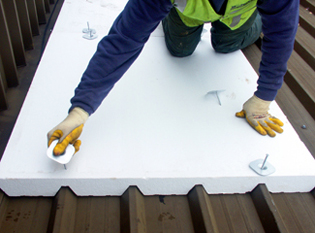
Molecular structure of EPS
Put simply, EPS is 98% air and 2% plastic. It uses styrene monomer as its base material. The monomer is a by-product of petroleum and naphtha produced during oil refining which provides a ready and continuous source. Styrene also occurs naturally in many foods such as strawberries, coffee beans, beer and wine.
Polystyrene is produced when the styrene monomer is polymerised into long chains. A gas called pentane is used as a non-CFC expansion agent to blow polystyrene into its final lightweight, expanded cellular form. During the production process, the pentane is quickly broken down into carbon dioxide and water. Pentane has low volatility. For example, it is found in the digestive systems of animals and created when vegetable matter decomposes in a process called anaerobic composting.
On the basis of current EU testing and classification regimes, styrene monomer is non-toxic in all normal usage and is not classified in terms of carcinogenicity or mutagenicity. Pentane has no potential to harm the ozone layer, unlike CFCs or HCFCs.
EPS has been made for more than half a century and EPS manufacturers comply with all current regulatory and legislative requirements. The processes include a combination of heat and pressure utilising clean technologies and minimising energy inputs and water usage through closed loop energy recycling. For all of these reasons, EPS manufacture is a highly efficient process.
No solid waste is created and process waste and off-cuts are immediately reintroduced to the production batch. Atmospheric and land/water emissions are strictly controlled, resulting in minimal localised impacts.

EPS used to insulate a floor
Due to the light weight of EPS and its relatively high volume, the EPS industry has grown to be located close to its home markets. This means that, in the UK, a number of strategic production sites enable the construction sector to have a constant, close supply of EPS to meet their continuous demands.
This also means that architects and construction specifiers selecting EPS building solutions can be reassured that all EPS is supplied to exacting standards from a trusted supplier. You can find the names of the UK’s leading suppliers to the construction industry (all of whom are BBA approved and are members of the British Plastics Federation) on this site’s Suppliers section. These companies can also be counted upon to provide expert support and advice to their architectural and construction customers.

Roofing insulated with EPS
EPS will save far greater impacts than it can ever generate, particularly when used as building insulation. This means that whatever resources go into the manufacture and supply of EPS, its exceptional performance will guarantee a far greater payback in resource reduction (such as heat saving) when installed in a building. In simple terms, EPS gives maximum return for minimal resource.